
E-commerce: towards a hyper-personalised customer experience
Personalisation is a never-ending quest that now requires a hyper-personalised experience.
As we well know, giving the impression that each customer is unique, that each product purchased or offer suggested is created especially for them is the whole idea behind personalisation and creating bespoke experiences. Let's see how this can translate to e-commerce. "Hey, how was personalisation before?" Looking back, we can recognise personalisation 1.0...
- By the product recommendations under the fold on the homepage, updated by the back-office teams once or twice a week, depending on if the profiles were logged in or not,
- At the bottom of the product page, the unmissable "Customers who bought this product also liked" with no scientific truth to back up the idea that they really did like the products in question,
- Nowhere in the purchase tunnel...everything was about transforming on what was put in the basket,
- Vaguely according to the depth of acquisition campaigns (analytics, affiliation, etc.),
- Finally, reduced to a few almost-unchanging segments in the promotional parts of newsletters.
Then, little by little with support from AI mechanisms as seen in my previous article, hyper-personalisation has expanded its scope of action to become an objective assigned to each marketing lever, from the initial points of contact with the brand, both on- and off-site.
Product customisation: the "You Marketing" era
Marking the initials of your clan on your trainers, your new-born's first name on a bottle of Coca-Cola, or a tender message on a jar of Nutella: we've all succumbed to the charms of the egotisation of consumer products. With increasingly sophisticated online configuration tools based on complex logistic and manufacturing philosophies, product customisation also plays a part in personalising experiences. Here are two examples from the luxury sector:
- The jeweller FRED
As illustrated by the image above, a configuration panel shows the composition interface (types of buckles, bracelets and colours) on the right and an image of the configured product on the left that updates dynamically as the customer makes their choices.
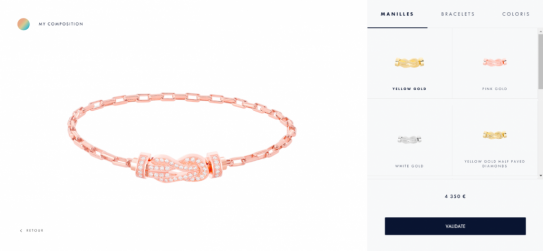
Source : https://www.fred.com/
Baume watches from Richemont Alongside an eco-responsible positioning (recyclable aluminium case, a lack of gold and precious metals, and a resin bracelet made from sea waste), these watches also have a configuration panel where no less than five attributes can be personalised, up to the choice of the hands themselves!
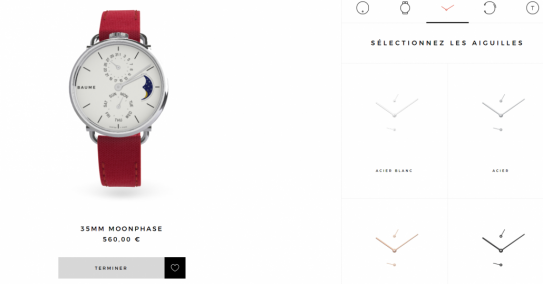
Source: https://www.baumewatches.com/fr-fr/moonphase-watch-configurator
The personalisation of user journeys
While custom products are everywhere on your favourite sites, personalisation 2.0 is also tackling user journeys. It's a given that, before testing the tools and the algorithm's results in action, a personalisation strategy must be defined that identifies the scope of application in the customer's life cycle and selects the appropriate channels and messages. Let’s review the main levers that an e-retailer can use:
- The home page, a privileged space for telling differentiated stories. Technically, in addition to a catalogue feed provided to the personalisation solution and the inclusion of a tag to retrieve various events on the site, a JavaScript call is included to display the recommendations supplied by the AI personalisation engine. In a way, the call takes over the templates present on the home page (slideshow, “Our Suggestions” area, etc.).

Source: https://www.kameleoon.com/sites/default/files/kam/documents/clubmed/success-story-club-med-perso-home.pdf (Example in French) (Homepage for “Mountain” visitors /Our mountain resorts….) - (Homepage for “Sun” visitors /Our sunny winter resorts…)
- Search, which has become a space of suggestions personalised according to the user’s previous searches and guided by faceting (a system of filters available to make results more relevant). The strategies can be refined by web merchandisers to manage product ranking according to various criteria (best sellers, new products, etc.).
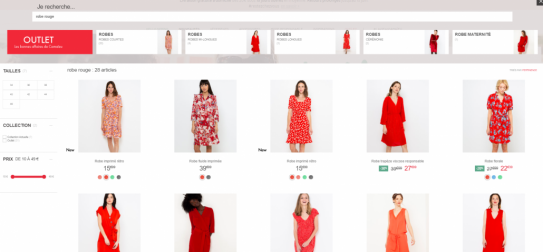
Source : https://www.camaieu.fr/
- The Product page in which hyper-personalisation will drive several complementary philosophies: products already seen, substitute products, complementary products. For example, Alltricks uses the Sparkow solution to suggest products related to sales, conversion and number of views.
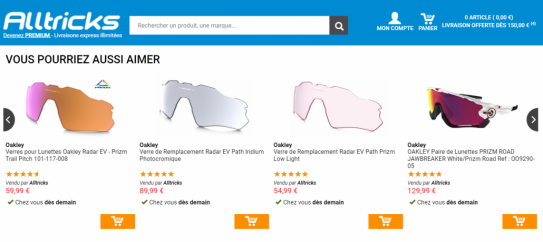
Source : sparkow.com/fr/
- Abandoned basket reminders
Using retargeting on social networks or, more traditionally, a reminder email, targeting now comes with product recommendations to further optimise conversion. This is the case with Finsbury supported by the Nosto solution:
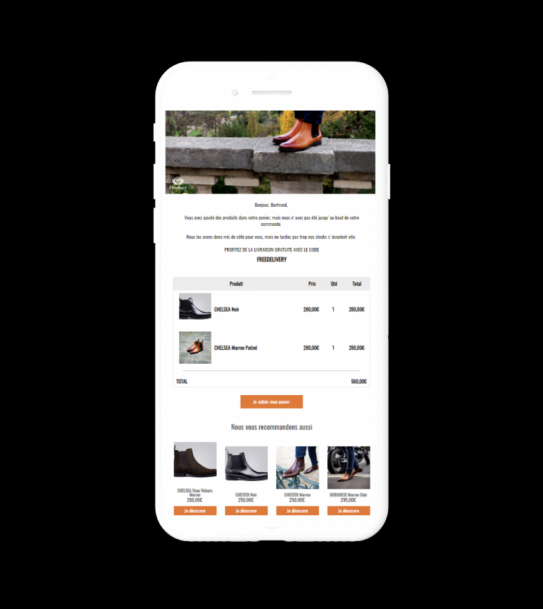
Source : https://fr.nosto.com/case-studies/finsbury/
Is ultra-personalisation the future?
Heralded several times as the guiding trend for the upcoming year, hyper-personalisation, by nature a never-ending quest, is no longer reserved to the biggest market players such as Amazon, Spotify or Netflix, but is steadily becoming part of the reality in systems and behaviour. It often optimises e-merchandising that results in an impulse purchase, serving brands’ business objectives and satisfying the customers’ need for recognition that is implicit in what personalised experiences offer.
In the future, we can bet that e-commerce and AI will combine to create almost as many versions of the site as there are visitors! A major challenge for web merchandisers will be in finding the right balance for journeys between an “over-personalised” cluster effect and the attractiveness of discovering a brand.